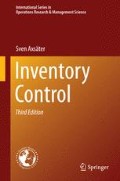Abstract
In Chaps. 3, 4, 5, and 6 it was assumed that different items in an inventory could be controlled independently. We shall now leave this assumption and consider situations where there is a need to coordinate orders for different items. In this chapter we shall still, as in Chaps. 3, 4, 5, and 6, assume that the items are stocked at a single location. (Multi-stage inventory systems are dealt with in Chaps. 8, 9, and 10.) We consider traditional inventory costs and constraints, i.e., holding costs, ordering or setup costs, and backorder costs or service constraints.
Access this chapter
Tax calculation will be finalised at checkout
Purchases are for personal use only
Author information
Authors and Affiliations
Corresponding author
Problems
Problems
(*Answer and/or hint in Appendix 1)
- 7.1*
-
7.2 *
-
(a)
Show that \(\int\limits_{ - 1/2}^{1/2} {e(u)du} = \frac{1}{{\sqrt 2 \ln 2}}\).
-
(b)
Show that the worst case will occur in (7.9) if x is uniform on (− 1/2, 1/2). What happens if we change q? Why?
-
(a)
-
7.3*
Three products are produced in a single machine. The demands are constant and continuous. No backorders are allowed. The following data are given
Table 5 -
(a)
Determine the independent solution and the corresponding lower bound for the optimal costs.
-
(b)
Show that the independent solution is infeasible.
-
(c)
Derive the common cycle solution and an upper bound for the total costs.
-
(d)
Apply Doll and Whybark’s technique. Is the solution feasible?
-
(a)
-
7.4
Demonstrate that the iterative procedure in Sect. 7.2.1.5 will converge.
-
7.5*
Three products are produced in the same machine. Various data are given in the table.
Table 6 -
(a)
Use a cyclic schedule with a common cycle. Determine batch quantities.
-
(b)
By using the technique by Doll and Whybark the following solution has been found:
-
Q1 = 460
-
Q2 = 230
-
Q3 = 184
-
Does this solution reduce the costs, and in that case how much. Is the solution feasible?
-
(a)
-
7.6
A company is producing three products in the same machine. There are 250 working days in 1 year, and 8 working hours per day. The following data are given:
Table 7 Determine the best cyclic plan with a common cycle time.
-
7.9
Consider (7.29). Show that the average time in the system T is minimized by choosing Q according to (7.30).
-
7.10
Consider the model in Sect. 7.3.1. Show that we, without changing the problem, can replace the holding costs h i by η i = h i d i , and set all demands equal to one.
- 7.11
-
7.12
Derive the condition (7.38).
-
7.13
Start with the solution obtained in Example 7.3 and check whether the tech- nique in Sect. 7.3.1.1 can improve the solution. This means that we no longer require a powers-of-two policy.
Rights and permissions
Copyright information
© 2015 Springer International Publishing Switzerland
About this chapter
Cite this chapter
Axsäter, S. (2015). Coordinated Ordering. In: Inventory Control. International Series in Operations Research & Management Science, vol 225. Springer, Cham. https://doi.org/10.1007/978-3-319-15729-0_7
Download citation
DOI: https://doi.org/10.1007/978-3-319-15729-0_7
Published:
Publisher Name: Springer, Cham
Print ISBN: 978-3-319-15728-3
Online ISBN: 978-3-319-15729-0
eBook Packages: Business and EconomicsBusiness and Management (R0)

